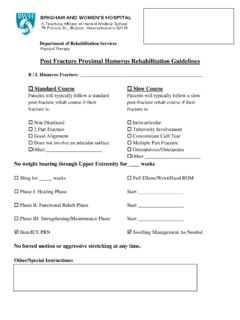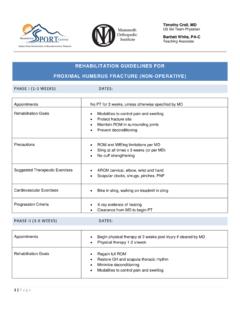Transcription of PROXIMAL HUMERAL FRACTURE (ORIF) - Ortho Illinois
1 750 E Terra Cotta Ave, Suite C. Crystal Lake, IL 60014. (815) 455-0800. Updated March 2014 PROXIMAL HUMERAL FRACTURE Post-Surgical rehabilitation protocol (OPEN REDUCTION / INTERNAL FIXATION). General Principles: 1. Bony healing occurs usually within 6 to 8 weeks in adults 2. Return to normal function and motion may require 3 to 4 months Overall Goals: 1. Increase ROM while protecting the FRACTURE site (you can be slightly more aggressive with this vs. a closed FRACTURE due to the hardware fixation). 2. Control pain and swelling (with exercise and modalities).
2 3. Perform frequent gentle exercise to prevent adhesion formation I. Phase I Early Motion Phase (0 5 weeks). A. Week 1 Early Passive Motion 1. Wear the sling at all times except to exercise 2. Hand, wrist, elbow, and cervical AROM. 3. Grip and wrist strengthening 4. PROM: ER to 30 and flexion to 130 . 5. Modalities as needed for pain relief or inflammation reduction B. Week 2 Active Assisted ROM. 1. Apply hot packs 10 minutes before exercising 2. Begin pendulum (Codman) exercises 3. Begin pulley for flexion and abduction 4.
3 Begin gentle AAROM flexion to 140 . 5. Supine ER with a stick to 40 . a. Keep arm in plane of scapula 6. Scapular Stabilization a. S/L scapular clocks b. Seated scapular retractions C. Week 3 4 AAROM and Isometrics 1. Continue all exercises 2. Begin S/L assisted forward elevation 3. Begin submaximal isometrics IR, ER, Flex, Ext, and ABD. 4. Begin flexion and ABD on slide board or table * Developed and approved by Rolando Izquierdo, 750 E Terra Cotta Ave, Suite C. Crystal Lake, IL 60014. (815) 455-0800. Updated March 2014 II.
4 Phase II Active Motion Phase (Week 4 12). A. Week 4 6 AROM. 1. Establish full PROM. 2. Begin AROM. a. Supine flexion with and without stick b. Progress to sitting (or standing) flexion with a stick c. Sitting flexion with elbow bent and arm close to the body d. Raise arm over head with hands clasped e. Perform ER and ABD with hands behind head f. Eccentric pulleys g. Sidelying ER. h. Prone Ext and ABD. i. Serratus Punches 3. Continue PROM and begin patient self stretching (week 6). a. Wall Walking b. Doorway ER stretch c.
5 S/L post. Capsule stretch 4. Begin multi-angle isometrics B. Week 8 Early Resisted ROM. 1. Begin Theraband for IR, ER, flexion, ABD, and extension 2. Begin supine IR, ER with 1# (with arm supported at 15 ABD). 3. Begin UBE no resistance 4. Progress to adding weight to above exercises only if pain-free 5. Biceps / Triceps strengthening with dumbbells III. Phase III Aggressive Stretching and Strengthening Phase (beginning week 12). 1. Isotonic strengthening with weights all directions 2. Increase theraband or use rubber tubing 3.
6 Increase stretches on door and add prone stretches 4. Begin functional or sport activity for strength gain * Developed and approved by Rolando Izquierdo.








